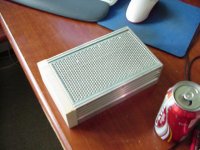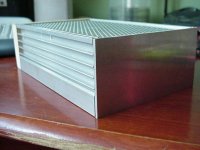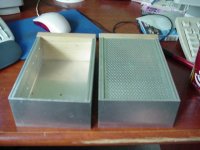New to finishing hardwoods too...
After rigourously sanding down the beech panels until silky smooth, I now need to apply a finish but I don't know what product to use. I've seen oils, waxes and varnishes available, but which is appropriate in this application? Is danish oil a good idea? Any pointers will be welcome!
After rigourously sanding down the beech panels until silky smooth, I now need to apply a finish but I don't know what product to use. I've seen oils, waxes and varnishes available, but which is appropriate in this application? Is danish oil a good idea? Any pointers will be welcome!
wax works good. now i just use minwax polyurethane clear satin
sand add a cote let dry sand again and final cote turns out nice
smooth
u going to stain it? cherry red looks sweet😀
sand add a cote let dry sand again and final cote turns out nice
smooth
u going to stain it? cherry red looks sweet😀
Vikash said:I did the front and back of the copper heatsinks on the disc sander today going through 150 grit, 320, 600 and finishing on 1200. I used WD40 up to 600 and then white spirit on the 1200 grit.
An externally hosted image should be here but it was not working when we last tested it.
There are still some marks in the direction of the disc which I'd like to remove. Can these be buffed out with a cloth and some kind of rubbing compound?
Hi!
I wonder - after achieving such beautiful finish - how to protect Cu plate so it don't "oxidize" anymore?!? Just to lacquer it or ...
freaky...this is exactly what I've been thinking about. In the space of less than a week I could no longer see a reflection in that piece of copper 🙄
I was thinking about lacquering it which will prevent it from oxidising, but I'm unsure whether I should leave the underside (which is then bolted to the aluminum base) and the area where the chip is bolted on, free of lacquer. Furthermore, will the copper heatsink get so hot that it will affect the lacquer coating?
I was thinking about lacquering it which will prevent it from oxidising, but I'm unsure whether I should leave the underside (which is then bolted to the aluminum base) and the area where the chip is bolted on, free of lacquer. Furthermore, will the copper heatsink get so hot that it will affect the lacquer coating?
Hi!
I see we have similar problems and points ...
I also intend to use that Cu "block" I have as a lid of my GC chassis and also as a heatsink at the same time - so I was thinking of making a "mirror look" and lacquering it only on the top side - and the bottom side left non-lacquerd - because both chips will be mounted there ...
Hmm - maybe Peter will have some idea and experiences with what had he done in the case of his Patek?!?
Oh btw - I seriously doubt the Cu plate will get so hot it would affect the lacquer ... I mean - my first finished GC (stereo version with lm1875)has both chips mounted on a 180 x 88 x 5mm Al plate - and it gets only slightly warm ... And the Cu has much higher density - so I guess it will need much more energy to absorbe to get to the same temperature ... And btw - maybe it's a solution to use a "temperature resistant" lacquer ... - eg the one you must "fry" in the oven at the first place ...
I see we have similar problems and points ...
I also intend to use that Cu "block" I have as a lid of my GC chassis and also as a heatsink at the same time - so I was thinking of making a "mirror look" and lacquering it only on the top side - and the bottom side left non-lacquerd - because both chips will be mounted there ...
Hmm - maybe Peter will have some idea and experiences with what had he done in the case of his Patek?!?
Oh btw - I seriously doubt the Cu plate will get so hot it would affect the lacquer ... I mean - my first finished GC (stereo version with lm1875)has both chips mounted on a 180 x 88 x 5mm Al plate - and it gets only slightly warm ... And the Cu has much higher density - so I guess it will need much more energy to absorbe to get to the same temperature ... And btw - maybe it's a solution to use a "temperature resistant" lacquer ... - eg the one you must "fry" in the oven at the first place ...
Vikash said:I was thinking about lacquering it which will prevent it from oxidising, but I'm unsure whether I should leave the underside (which is then bolted to the aluminum base) and the area where the chip is bolted on, free of lacquer.
I would definitely not lacguer the contact area surfaces (especially for the chip). If you use thermal compound it should be enough protection against oxidization.
As to my Patek, the panels were brushed and not protected at all. I like to see copper age naturaly 😉
I'm planning on using some patina formulas, to make the look more pleasing: http://www.coscosci.com/patinas/patinaformulas.htm
Hi Peter!
Well in my case I'm not afraid that the Cu will age - that doesn't bother me - but how to prevent it against different people with "Iiiii, what a beautiful surface - can I touch it ...." sindrom .... - because as far as I understand - fingerprints on bare Cu result in blask spots 🙁
Well in my case I'm not afraid that the Cu will age - that doesn't bother me - but how to prevent it against different people with "Iiiii, what a beautiful surface - can I touch it ...." sindrom .... - because as far as I understand - fingerprints on bare Cu result in blask spots 🙁
This is the same piece of copper with the effects of oxidisation and finger marks.
I guess that if people can see it to touch it, then lacquer it.
An externally hosted image should be here but it was not working when we last tested it.
I guess that if people can see it to touch it, then lacquer it.
after working with copper fore a few years on pc-watercooling i'v gathered up a few tips..
for cleaning without wearing the surface use bakingpowder and a bowl of steaming hot water. you can altso use vinegar (?) and table salt, althog this tkes a bit longer.
for cleaning without wearing the surface use bakingpowder and a bowl of steaming hot water. you can altso use vinegar (?) and table salt, althog this tkes a bit longer.
Vikash - I think that the main guilt for that look are just the fingerprints - if I see correct - in the holes there is still nice shinning Cu ...
Any practical ideas with what kind of lacquer I can lacquer the plates?
Any practical ideas with what kind of lacquer I can lacquer the plates?
Copper must be plated by galvanic nickel, followed by galvanic gold - it is for ever. Try any jewelery 😉 .
I know about galvanisation - but I would like to have bare Cu look of the front&back plate and of the top ....
OK, try after finishing paint it ( in several times thin coat by spray ) by paint for photography ( zappon paint ).
Hehe - now we're talking 😀
Aha - spray is probably better solution, you're right ... I' just wasn't sure which lacquer to use ...
Thanks!
Aha - spray is probably better solution, you're right ... I' just wasn't sure which lacquer to use ...
Thanks!
Maybe an idea??
Hmm - I've just thought it out - how about using spray with which you protect PCBs?? I mean - traces on PCB are copper - so I gues it would perfectly attache to the cooper surface ...
But then again - it is maybe a bit too shiny effect ...
Hmm - I've just thought it out - how about using spray with which you protect PCBs?? I mean - traces on PCB are copper - so I gues it would perfectly attache to the cooper surface ...
But then again - it is maybe a bit too shiny effect ...
You need thin coat - this paint is not ! You need look like without painting and this solution look " like " painted 😉 .
- Status
- Not open for further replies.
- Home
- Amplifiers
- Chip Amps
- Case and metal working


